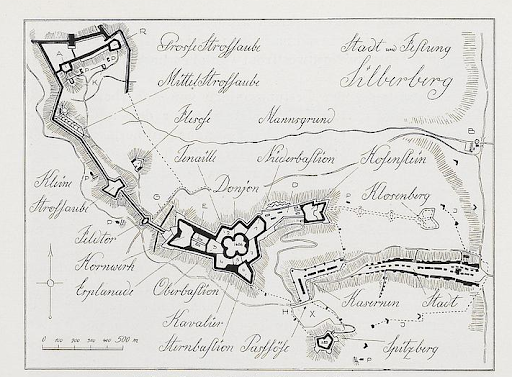Contact
Twierdza Srebrna Góra sp. z o.o.
ul. Kręta 4
Phone: +48 74 818 00 99
E-Mail
Website
The former Prussian fortress Silberberg in the Polish Srebrna Góra is a touristic highlight of the region Lower Silesia. Embedded in the woody mountains of the Owl Mountains, the monumental fortress system was built in the 18th century and has never been beaten by enemies ever since.
Experience World
Fortress culture park Srebrna Góra
The fortress system Srebrna Góra is not only the biggest mountain fortress in Europe with an area of 150 ha, but the bastion Donjon also holds the height record.
Donjon/ Donżon
The Donjon was developed as a reduit fortress with four cylindrical casemate artillery towers connected to each other and was part of the first construction stage of the fortress system (1765-1768). It has a shield wall with trench casemates and outer works. Altogether this three-story building on the Brandlehde mountains accommodates 151 single rooms.
Upper Bastion/ Bastion Górny
The Upper Bastion, which originally looked similar to the Lower Bastion, has only been restored recently and is not accessible for visitors. Originally a bridge led from Donjon to the Upper Bastion. A tunnel allows a fortress tour through the Upper Bastion.
Lower Bastion/ Bastion Dolny
The restored Lower Bastion, today, welcomes fortress visitors in the „Kantyna“ with snacks and refreshments. With metal detectors small and big visitors can go on a treasure hunt next door. Just in 2015 a silver gallery was found. An exhibitions in the Bastion Neudorf/Nowowiejska informs about this discovery.
Fort Hohenstein/ Fort Wysoka Skała
The zigzag formed fortresses Hohenstein and Hornwerk, called Tenaille in fortress architecture, are surrounded by a deep trench cut in stone.
Fort Spitzberg/ Fort Ostrog
The polygonal Fort Spitzberg / Lunette Spitzberg is today called Fort Ostrog. The well in Fort Spitzberg is 84m deep.
Bastion Kavalier
In Bastion Kavalier, today, sheep and goats took up the quarters in fortress Silberberg.
Fort Kleine Strohhaube
Also the fort Kleine Strohhaube was built in old Prussian manner from 1765-1777 and was equipped with an own well. Today only a few rests of the wall in the mountain landscape remind of this part of fortress Silberberg.
Outwork Große Strohhaube
The outwork Große Strohhaus was located North-West of the Kleinen Strohhaube and was built from 1765-1777. Only a few fragments of this fortress have been preserved.
Hornwerk and Esplanade/ Fort Rogowy z esplanadą
Fort Hornwerk, pincer-shaped like Fort Hohenstein, is surrounded by a deep trench cut in stone.
Tour Offers and Information
Costume tours and exhibition - Fort Ostrog
Fortress tours in Prussian uniforms
Night tour through the fortress
Historic shooting range
Historic shooting range / casemate Donjon with different kinds of automatic weapons, guns and pistols
Singletrack Glacensis
Sudetes MTB Zone (largest cycle path network in Poland)
Zip Line
Zip Line - 570 m tour with zip line Link and Information?
Map
Monument and History
History On 15th February 1763 Frederick the Great ordered the building of a fortress at the pass of the Silberberg. The Seven Year War was ended on this day by the peace of Hubertusburg / Saxony. Fortress Silberberg was to secure the Silesian earldom Glatz the on-site fortress Glatz /Klodzko in case of a new war for Frederick II and to enable a advance to Austria. No Prussian province had as many fortresses as Silesia (see plan).
Quelle: ©regiment.forty.pl Quelle: public domain Quelle: © SPSG
Architecture Fortress Silberberg was built in old Prussian manner. The construction after the ideas of lieutenant colonel Ludwig Wilhelm Regeler was divided in three stages from 1765 to 1777. At first the central bastion was built, the Donjon with a surrounding envelope. This polygonal reduit fortress with four cylindirical casemate artillery towers was probably built following the polygonal fortress Marquis Montalemberts and the round fortress of Albrecht Dürer.
Quelle: Source: Bleyl, Die Passfestung Silberberg Quelle: ©Twierdza Srebrna Gora Quelle: ©Twierdza Serbra Gora
Nature Experience Spectacular views over mountain landscape with wide forests wait for hikers, cycle tourists and of course fortress visitors on their way through the Owl Mountains (Hóry Sowie). It reaches from the Waldenburg mountains to the pass of Silberberg in the South-East (Przełęcz Srebrna) with its mighty fortress sytsem.Singletrack Glacensis
Quelle: ©Singletrack Glacensis Quelle: © Twierdza Srebrna Gora Quelle: © Twierdza Srebrna Gora
Partner



